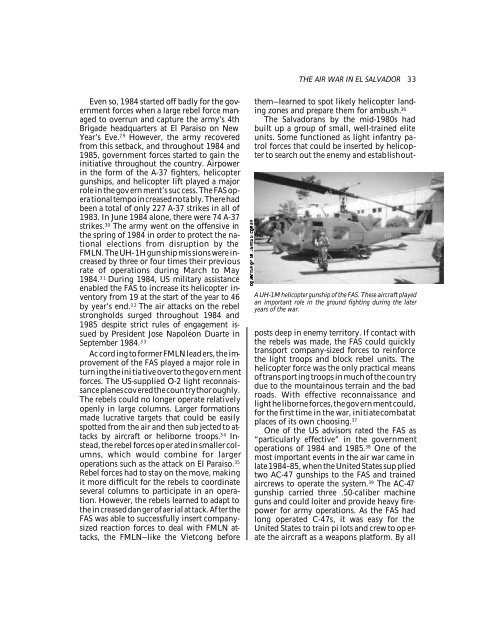The Air War in El Salvador - Air and Space Power Journal
The Air War in El Salvador - Air and Space Power Journal
The Air War in El Salvador - Air and Space Power Journal
You also want an ePaper? Increase the reach of your titles
YUMPU automatically turns print PDFs into web optimized ePapers that Google loves.
Even so, 1984 started off badly for the govern<br />
ment forces when a large rebel force managed<br />
to overrun <strong>and</strong> capture the army’s 4th<br />
Bri gade headquar ters at <strong>El</strong> Paraiso on New<br />
Year’s Eve. 29 However, the army recov ered<br />
from this setback, <strong>and</strong> throughout 1984 <strong>and</strong><br />
1985, govern ment forces started to ga<strong>in</strong> the<br />
<strong>in</strong>i tia tive throughout the country. <strong>Air</strong>power<br />
<strong>in</strong> the form of the A-37 fighters, helicop ter<br />
gun ships, <strong>and</strong> helicop ter lift played a major<br />
role <strong>in</strong> the gov ern ment’s suc cess. <strong>The</strong> FAS opera<br />
tional tempo <strong>in</strong> creased no ta bly. <strong>The</strong>re had<br />
been a total of only 227 A-37 strikes <strong>in</strong> all of<br />
1983. In June 1984 alone, there were 74 A-37<br />
strikes. 30 <strong>The</strong> army went on the offen sive <strong>in</strong><br />
the spr<strong>in</strong>g of 1984 <strong>in</strong> order to protect the national<br />
elections from disrup tion by the<br />
FMLN. <strong>The</strong> UH- 1H gun ship mis sions were <strong>in</strong>creased<br />
by three or four times their previ ous<br />
rate of opera tions dur<strong>in</strong>g March to May<br />
1984. 31 Dur<strong>in</strong>g 1984, US military assis tance<br />
en abled the FAS to <strong>in</strong>crease its helicop ter <strong>in</strong>ven<br />
tory from 19 at the start of the year to 46<br />
by year’s end. 32 <strong>The</strong> air attacks on the rebel<br />
strong holds surged throughout 1984 <strong>and</strong><br />
1985 despite strict rules of engage ment issued<br />
by President Jose Napoléon Duarte <strong>in</strong><br />
Sep tem ber 1984. 33<br />
Ac cord <strong>in</strong>g to former FMLN lead ers, the improve<br />
ment of the FAS played a major role <strong>in</strong><br />
turn <strong>in</strong>g the <strong>in</strong>i tia tive over to the gov ern ment<br />
forces. <strong>The</strong> US-supplied O-2 light recon naissance<br />
planes cov ered the coun try thor oughly.<br />
<strong>The</strong> rebels could no longer oper ate relatively<br />
openly <strong>in</strong> large columns. Larger forma tions<br />
made lucra tive targets that could be easily<br />
spot ted from the air <strong>and</strong> then sub jected to attacks<br />
by aircraft or heliborne troops. 34 Instead,<br />
the rebel forces op er ated <strong>in</strong> smaller columns,<br />
which would comb<strong>in</strong>e for larger<br />
op era tions such as the attack on <strong>El</strong> Paraiso. 35<br />
Re bel forces had to stay on the move, mak<strong>in</strong>g<br />
it more diffi cult for the rebels to coor di nate<br />
sev eral columns to partici pate <strong>in</strong> an operation.<br />
However, the rebels learned to adapt to<br />
the <strong>in</strong> creased dan ger of aer ial at tack. Af ter the<br />
FAS was able to success fully <strong>in</strong>sert companysized<br />
reac tion forces to deal with FMLN attacks,<br />
the FMLN—like the Vietcong before<br />
THE AIR WAR IN EL SALVADOR 33<br />
them—learned to spot likely helicop ter l<strong>and</strong><strong>in</strong>g<br />
zones <strong>and</strong> prepare them for ambush. 36<br />
<strong>The</strong> Salva dorans by the mid-1980s had<br />
built up a group of small, well-tra<strong>in</strong>ed elite<br />
units. Some functioned as light <strong>in</strong>fan try patrol<br />
forces that could be <strong>in</strong>serted by helicopter<br />
to search out the enemy <strong>and</strong> estab lish out-<br />
A UH-1M helicopter gunship of the FAS. <strong>The</strong>se aircraft played<br />
an important role <strong>in</strong> the ground fight<strong>in</strong>g dur<strong>in</strong>g the later<br />
years of the war.<br />
posts deep <strong>in</strong> enemy terri tory. If contact with<br />
the rebels was made, the FAS could quickly<br />
trans port company-sized forces to re<strong>in</strong> force<br />
the light troops <strong>and</strong> block rebel units. <strong>The</strong><br />
heli cop ter force was the only practi cal means<br />
of trans port <strong>in</strong>g troops <strong>in</strong> much of the coun try<br />
due to the mounta<strong>in</strong> ous terra<strong>in</strong> <strong>and</strong> the bad<br />
roads. With effec tive recon nais sance <strong>and</strong><br />
light he liborne forces, the gov ern ment could,<br />
for the first time <strong>in</strong> the war, <strong>in</strong>iti ate com bat at<br />
places of its own choos<strong>in</strong>g. 37<br />
One of the US advi sors rated the FAS as<br />
“par ticu larly effec tive” <strong>in</strong> the govern ment<br />
op era tions of 1984 <strong>and</strong> 1985. 38 One of the<br />
most impor tant events <strong>in</strong> the air war came <strong>in</strong><br />
late 1984–85, when the United States sup plied<br />
two AC-47 gunships to the FAS <strong>and</strong> tra<strong>in</strong>ed<br />
air crews to oper ate the system. 39 <strong>The</strong> AC-47<br />
gun ship carried three .50-caliber mach<strong>in</strong>e<br />
guns <strong>and</strong> could loiter <strong>and</strong> provide heavy firepower<br />
for army opera tions. As the FAS had<br />
long oper ated C-47s, it was easy for the<br />
United States to tra<strong>in</strong> pi lots <strong>and</strong> crew to op erate<br />
the aircraft as a weapons platform. By all

















